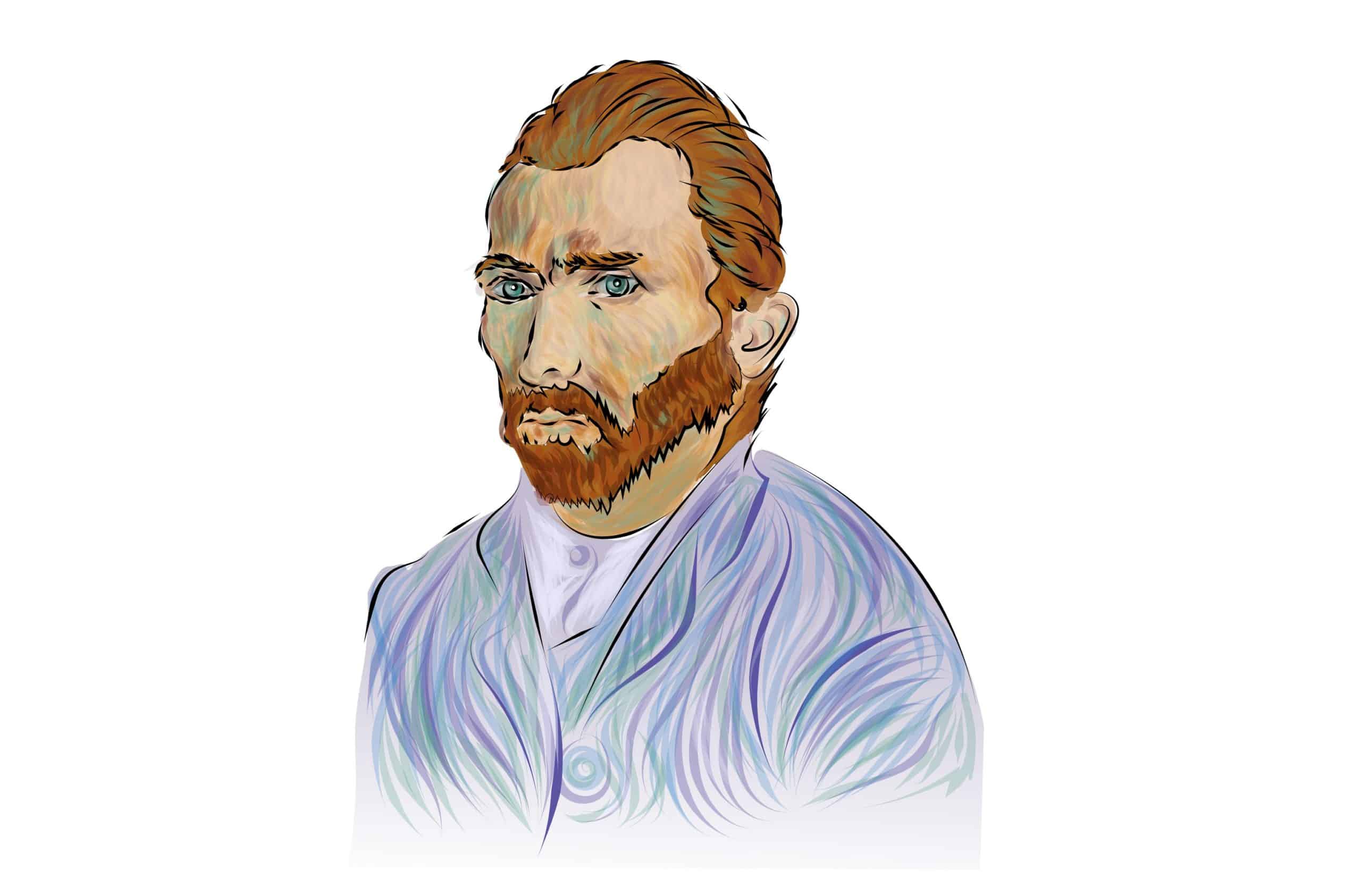This blog post is the biography of Vincent Van Gogh. Vincent Van Gogh was a post-impressionist painter who is considered one of the top ten painters of all time. His paintings, which cost millions of dollars, are studied by art lovers all over the world. The museum dedicated to him, the Vincent Van Gogh museum in Amsterdam, is visited by almost 2 million people every year.
Yet, despite his fame, he lived a very sad life as an unsuccessful artist. At the time of his death, he was single, had sold only one painting, had been admitted in a mental asylum, and did not have a stable job. His words, 'Sadness will last forever,' after he shot himself, stand testimony to the sad life he lived.
Read the biography of Vincent Van Gogh. Understand how one of the most misunderstood people of the nineteenth century became a celebrated artist in the twentieth century.
Early Life
Birth
Theodorus Van Gogh worked as a pastor in the Netherlands during the nineteenth century. His older brother was Vincent Van Gogh. Vincent married a woman who came from a wealthy family on the western coast of the Netherlands. During their wedding, Theodorus met the bride's elder sister Anna Cornelia Corbentus, and they were attracted to each other. Soon their mutual attraction turned into love, and Theodorus and Anna got married in May 1851.
One year later, on March 30th, 1852, their first son was born. They named him Vincent Willem Van Gogh. However, the baby was born dead.
Exactly one year later, on March 30th, 1853, in Zundert, Netherlands, their second son was born. The couple, who were still grieving the death of their first son, gave the same name to their second son as well. Their second son, Vincent Willem Van Gogh, would later grow up and become a world-renowned artist.
After Vincent's birth, the couple had five more children - two sons and three daughters. Of his five siblings, his younger brother Theodorus, also known as Theo, would become Vincent's biggest patron, friend, and supporter.
Childhood
Even as a child, Vincent was eccentric due to his choice of clothes and his eating habits. Unlike the other children, he was serious, thoughtful, and loved to be alone. He loved birds, insects, and flowers.
Vincent Van Gogh did his early schooling at a local village school. In 1864, when he was 11 years old, his parents sent him to a boarding school. Vincent, who felt alone and abandoned in the new school, wanted to return home. But instead of letting him return home, his parents sent him to another middle school two years later. This school, which was in Tilburg, had a dedicated art teacher. But Vincent, who was overcome by sorrow, focused little on art. His early paintings during this time were average and showed no hints of the famous artist he would later become.
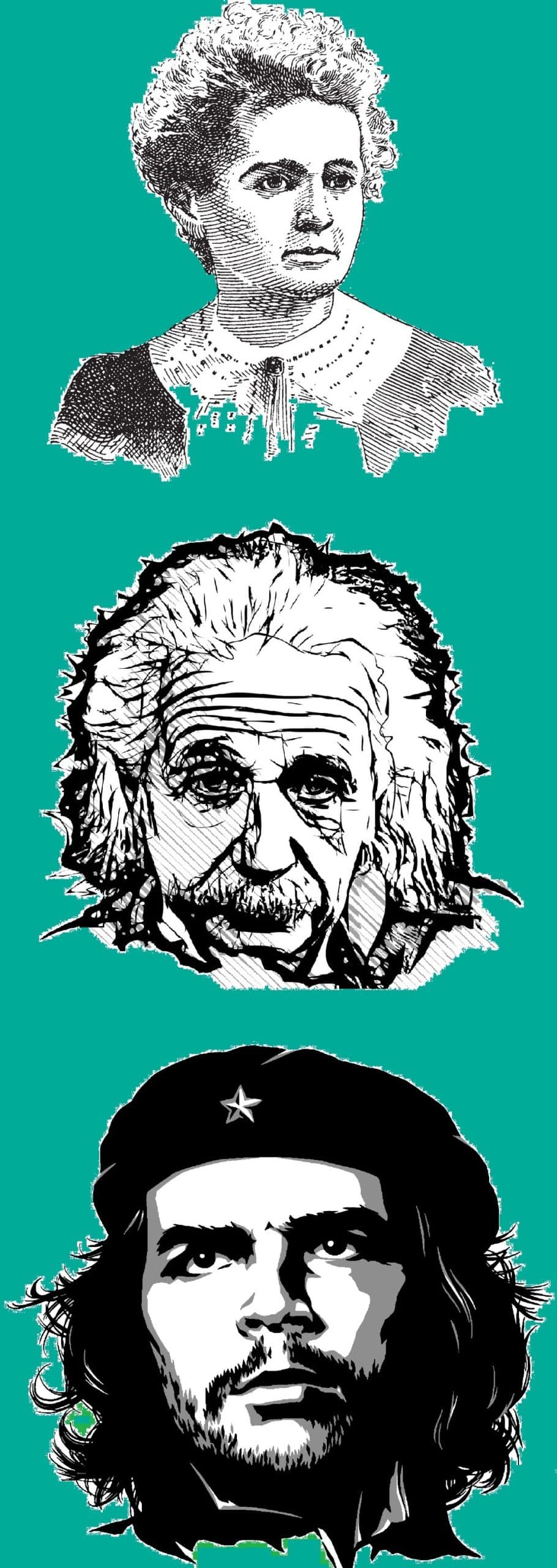
A Titbit About A GREAT Personality In Your Inbox Everyday
Find out how people changed our world and made history while doing it. Find out what motivated them to become their best self. Find out how they found innovative solutions to impossible problems.
Get a peek into the life of a great personality every day.
In 1868, after spending two years at the school, Vincent abruptly returned home. The reason for this was probably that this new school proved to be too costly for his parents. After all, even though the church provided his family with a house, several servants, a carriage, and a horse because his father was a pastor, his father's salary was modest.
After returning from school, Vincent spent a year at home.
First Job
Goupil and Co. was a company in the nineteenth century that bought, reproduced, and sold famous artworks. Vincent's uncle, Vincent Van Gogh, also known as uncle cent by his nephews, was a partner in that company. Since he did not have any children of his own, he loved his nephews. So, in 1869, he secured a job for sixteen-year-old Vincent as a junior clerk in his company's branch in the Netherlands.
First letter
Vincent initially loved his job and worked hard. He showed remarkable results in the art business, impressing his superiors. However, like in all his later endeavors, Vincent soon grew frustrated and depressed with his job. This led to the first reported incident of his psychological condition, most likely, bipolar disorder.
Alarmed at his mental state, his brother Theo came to visit him. When Theo returned home after visiting Vincent, Vincent was saddened by his departure. So, he wrote a letter to Theo in 1872. This letter would become the first recorded letter of the 819 letters Vincent wrote to Theo and others. These letters helped reconstruct Vincent's life and made Vincent one of the few artists whose lives have been so well-documented. (You can check out all the letters Vincent Van Gogh sent and received by visiting this website.)
London
In 1873, the company promoted Vincent and transferred him to its London branch. His brother Theo took Vincent's position in the Netherlands branch of Goupil and Co. This year was the happiest year of Vincent's life. Even though he was just 20 years old, he was earning more than his father.
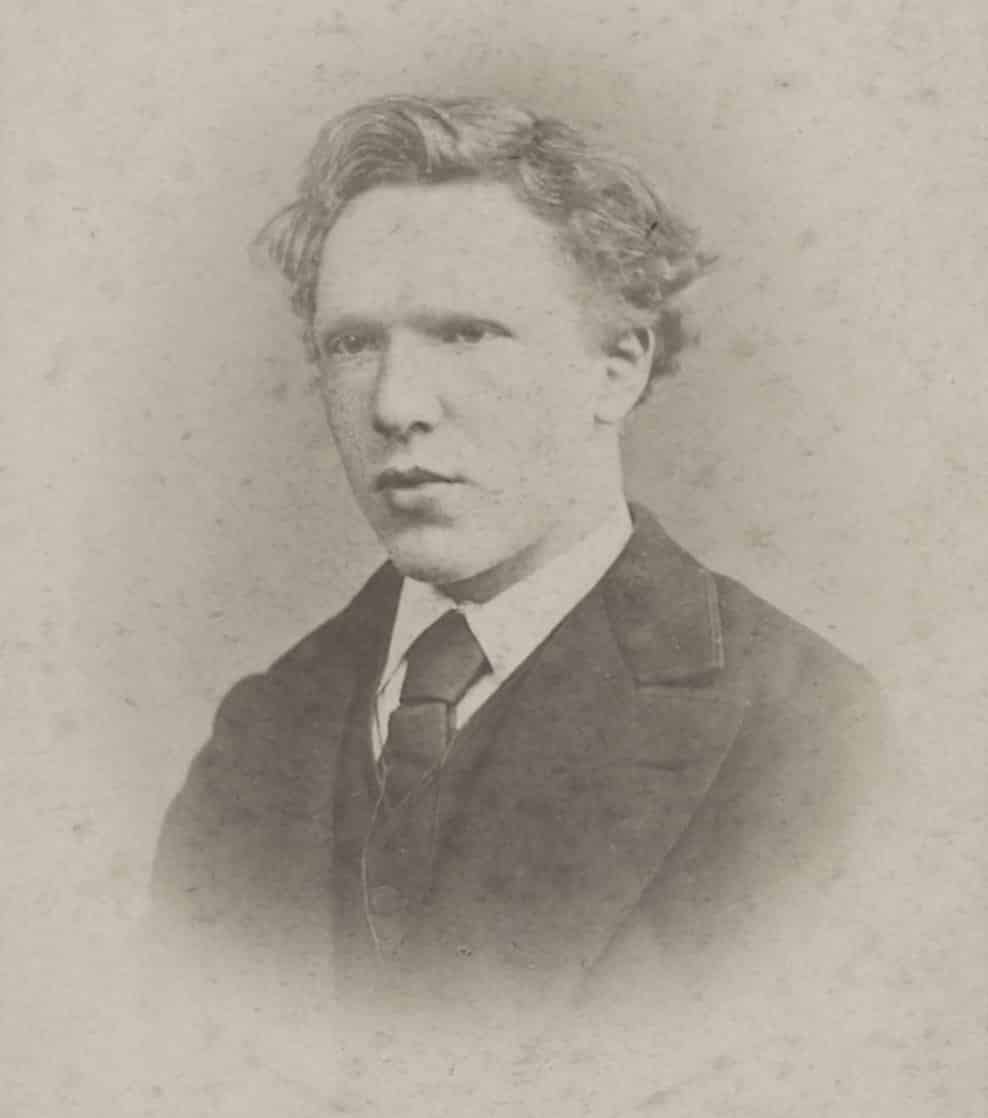
Vincent Van Gogh in 1873, when he worked for Goupil & Co. - By Jacobus Marinus Wilhelmus de Louw (1823–1907) - Memory of the Netherlands, From Vincent van Gogh: letters, art, and context of the Van Gogh Museum, Public Domain, Link
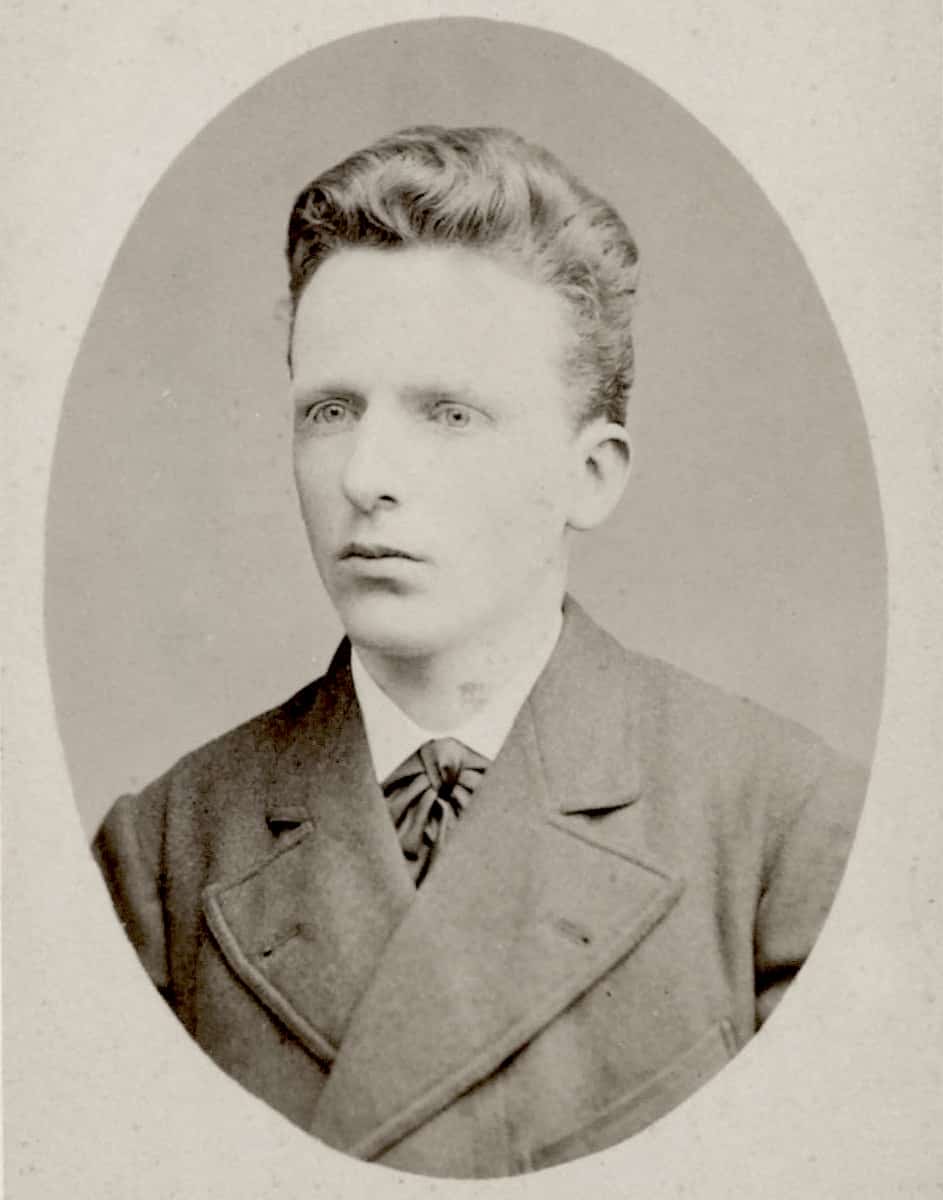
Theo in 1878 - By De Lavieter & Co - Memory of the Netherlands, From Vincent van Gogh: letters, art, and context of the Van Gogh Museum, Public Domain, Link
Falling in love with landscape paintings
Vincent's job in London transformed his life, exposing him to English arts and literature. Vincent loved English literature, especially the works of Charles Dickens and William Shakespeare. However, he wasn't attracted to English paintings. Instead, he loved the works of Dutch painters like Rembrandt.
Vincent also loved the form of art called realism, which focused on painting average, working-class people, and day-to-day happenings. So, the works of French and Dutch realist painters, as well as landscape paintings, fascinated him. Uncoincidentally, it is also during this time that Vincent formed his initial opinions about the importance and role of art.
First love
During his stay in London, Vincent fell in love with his landlord's daughter. But she rejected him because she was already secretly engaged to someone else. After being rejected by his first love, Vincent became more introverted and isolated. Alarmed at his situation, his uncle transferred him to Paris, to distract him from his grief. However, it did not help him forget his sorrows, and by 1875, Vincent had become utterly miserable. At times, his thoughts became suicidal and triggered an existential crisis within him.
Searching for a reason for his existence, Vincent became profoundly religious and started reading the Bible compulsively. His interest in religion and his disapproval of the extent to which the company commodified art made him lose interest in his job. So, when he went home for Christmas without informing his company, Goupil and Co. fired him.
In 1876, after losing his job, Vincent worked odd jobs, like being a temporary teacher and selling books.
Interest in Religion
Attempting to study religion
In 1877, looking at his interest in religion, his family sent him to Amsterdam to prepare for the University of Amsterdam's theology entrance examination. He prepared for the entrance exam while living with his uncle, who was a respected theologist. During this time, Vincent also started to read and draw extensively.
While preparing for the exams, Vincent found the requirements on Latin, Greek, and Mathematics, subjects unrelated to religion, to be too high. So, he quit it in July 1878.
Thereafter, he went to Brussels to join a shorter three-month course to become an Evangelist missionary. However, after joining the course, he found out that he did not like it either. So, he quit again and went to Borinage, a coal-mining district in Belgium, where he volunteered to be a missionary.
Becoming a missionary
After working without pay for months, in January 1879, Vincent managed to get a temporary paid job. The church provided him wages and lodgings to take care of the sick people and teach the Bible. However, wanting to show support for poor families, Vincent gave up the lodgings provided to him by the church to a homeless person. Instead, he stayed in a small hut and slept on straw. This annoyed the church authorities, who considered Vincent's acts as disrespect towards the church. So, they asked him to leave.
Another existential crisis
After losing his paid job, he moved to another town called Cuesmes and started preaching without pay. His service to the sick and needy in Cuesmes earned him the respect of the residents. But even though the people liked him, Vincent understood that he had failed as a preacher. After all, he could neither convince the people nor preach in a way simple enough for them to understand. This triggered another existential crisis in him, and once again, he started wondering if he could be of any use in the world.
Wondering what to do with his life, Vincent, who liked the miners, their lives, and the scenes around them, started capturing them in his drawings. Then he sent these sketches to his brother, along with the letters he sent him. His brother Theo, who looked at these sketches, urged him to pursue a career as an artist.
Life as an artist
Heeding to his brother's advice and eager to establish his presence in the world through his art, in 1880, Vincent Van Gogh went to Brussels to learn from the Dutch artist Willem Roelofs. Willem convinced Vincent to enroll in the Belgian art school. So, Vincent enrolled in the art school and learned the concepts of anatomy, modeling, and perspective. However, as usual, Vincent soon became restless and wanted to move to the countryside to draw landscapes and peasant life. But since he was living off the monthly allowances from his father and his brother Theo, he couldn't do as he pleased. So, in 1881, due to financial struggles, he moved to the Netherlands to live with his parents once again.
Learning to use Charcoal and Pastels
Even though Vincent Van Gogh was living with his parents at the age of 28, his time at home helped him better his painting skills. It is during this time that Vincent started painting portraits, using his sister as a model. He also learned to paint using Charcoal and Pastels from a cousin and famous Dutch Realist painter Anton Mauve.
Anton realized Vincent's potential as an artist and encouraged him to continue drawing. Enthusiastic, Vincent wrote to Theo, telling him that what he had previously thought impossible was becoming possible now.
Vincent's love for landscapes and painting ordinary people had not left him yet. So, he started painting these scenes using the new techniques he had learned. His paintings like 'Coal shoveler', 'Portrait of an Elderly Gentleman,' and 'Farmer Sitting by the Fireplace, Reading,' were painted during this time.
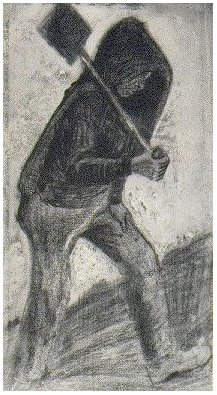
Coal Shoveler, July 1879 - Van Gogh, Vincent. Coal Shoveler 1879. Kröller-Müller Museum.
The Van Gogh Gallery. “Coal Shoveler.” 9 October 2020
https://www.vangoghgallery.com/catalog/Drawing/848/Coal Shoveler.html.
Another failed love
Even though the time living with his parents benefitted his art skills, it brought him pain. In 1881, when his cousin Kee Vos, who had been recently widowed, visited him, he fell in love with her. Even after she refused to accept his marriage proposal, he persisted, annoying both his parents and Kee's parents.
Learning to use oil
Heartbroken by another failed love attempt, Vincent left home and went to the city where Anton Mauve was living. Anton taught him how to use oil to paint and lent him money to set up a studio. But despite Anton helping Vincent, they eventually fell apart due to differences in opinion.
One more failed love
Vincent, who had little to no money, could only hire people from the street to be his models. In 1882, while using a prostitute as a model for one of his paintings, Vincent fell in love with her. Their love grew, and after a year, the prostitute and her little daughter started living with Vincent. The prostitute, called Sien Hoornik, was pregnant due to another man. She had lost two children during infancy and was abandoned by all the four men who fathered her children. So, Vincent decided to marry her because he didn't want her to feel abandoned anymore. But his family opposed his decision vehemently. Therefore, 18 months after they first met, they broke up because she didn't share Vincent's love for art and also because Theo objected to his brother's decision to marry a former prostitute. Sien would become the only woman with whom Vincent lived.
Heartbroken once again, Vincent van Gogh traveled to a desolate district in the Netherlands and started living like a nomad. But by the end of 1883, he started feeling too lonely. So, he moved in with his parents once again.
Improving his technique
While living with his parents, Vincent Van Gogh painted weavers and their cottages. His famous painting 'The Parsonage Garden at Nuenen' was painted during this time. In the next two years, he painted at a very rapid pace, finishing almost 200 oil paintings and numerous watercolors and drawings. By this time, Vincent's technique had improved a lot. However, he was merely adopting the style of other Dutch artists and hadn't created his own style yet.
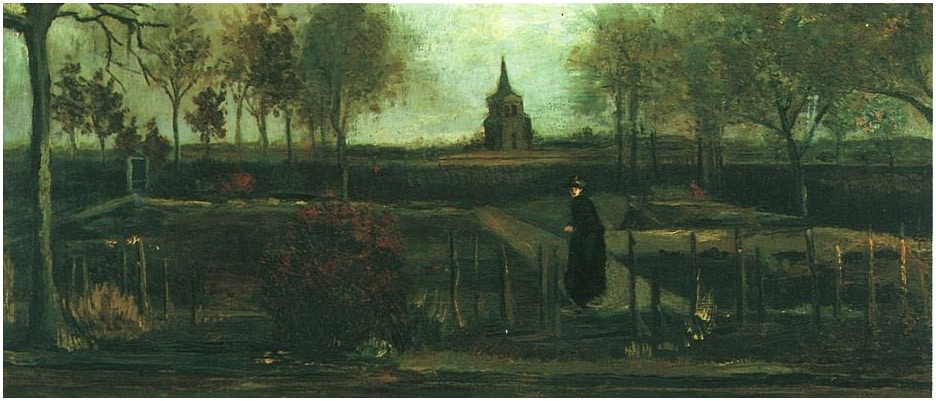
Parsonage Garden at Neunen, May 1884 - Van Gogh, Vincent. Parsonage garden at Neunen, 1884. Groninger Museum.
The Van Gogh Gallery. “Parsonage garden at Neunen.” 9 October 2020
https://www.vangoghgallery.com/catalog/Painting/387/Parsonage Garden at Nuenen, The.html.
At that time, Theo was working in Paris, which was the world center of art at that time. So, Vincent sent his paintings, including his first major work, 'The Potato eaters,' to Theo to sell them. But Theo couldn't sell any of them because they were darker compared to the bright impressionist paintings, which people loved.
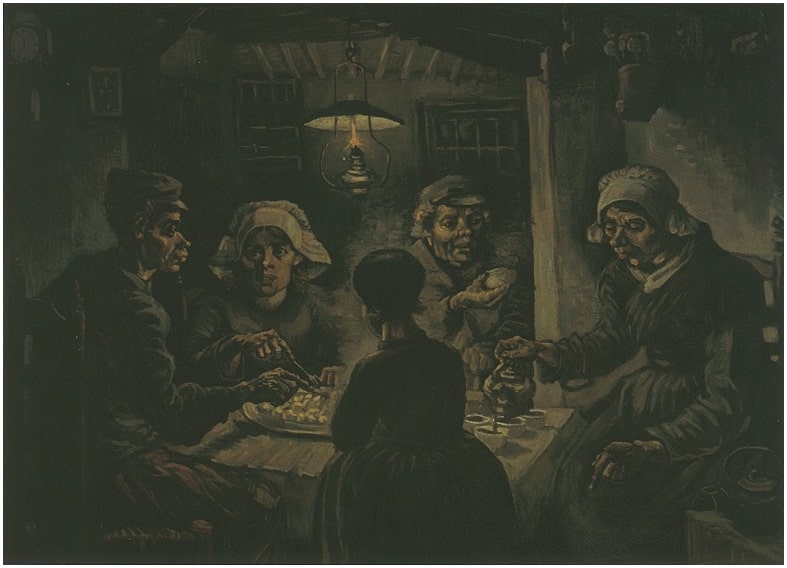
Potato eaters, April 1885 - Van Gogh, Vincent. Potato eaters, 1885. Van Gogh Museum.
The Van Gogh Gallery. “Potato eaters.” 9 October 2020
https://www.vangoghgallery.com/catalog/Painting/453/Potato Eaters, The.html.
Antwerp
In November 1885, Vincent moved to Antwerp to study at the Academy of Fine Arts. During this time, he became interested in Japanese art and the works of Monet and other impressionist painters.
In January 1886, hoping to improve his understanding of figure drawing, the practice of drawing from a live model in different poses, Vincent enrolled at the Academy. After attending the first drawing classes, he found out, to his dismay, that the Academy doesn't use nude models. So, he used the money, which Theo sent him, to hire nude models and buy painting materials. Therefore, he had only very little money left for food.
For several months, he survived on bread, coffee, and tobacco alone. As a result, he became ill, and his teeth became loose and painful. Moreover, he got into conflict with his instructors and teachers due to his unconventional painting style. So, in March 1886, he moved to Paris, where Theo was.
Paris
After moving in with Theo, Vincent started working as an apprentice for the painter Fernand Cormon. This allowed him to meet other painters, who became his friends. With the help of Theo, who was selling realist and impressionist paintings, he could meet several impressionist painters, including Monet. Finally, Vincent Van Gogh felt that he was a part of a community of artists. Moreover, he got ample opportunity to study the techniques of other painters and greatly admired the work of Monticelli.
Creating his unique style
As a result, in two years, from March 1886 to February 1888, Vincent Van Gogh's techniques improved at an extraordinary rate. He created his own style by studying Impressionist paintings, Japanese art, and the techniques used by old Dutch painters. He aimed to distort the reality and natural laws to express deep, intense emotions and touch people. So, he went beyond the confines of Impressionism. He utilized opposing colors to harmonize brutal extremes, while distorting and exaggerating forms to convey the overwhelming emotions he felt deep within him.
This unique style of art was appreciated by several artists when he exhibited his paintings in 1888. But despite the growing interest among fellow artists for his paintings, he couldn't sell a single painting.
The decision to relocate
Vincent's artistic skills improved tremendously during his stay in Paris, whereas his health deteriorated terribly. He often neglected his health while painting rigorously. His drinking habits and poor eating habits, along with his previous psychological condition, led to depression, violent mood swings, and erratic behavior.
In a letter to his sister, Theo remarked how living with Vincent felt like living with two people - a gifted, delicate person and another heartless, selfish person. In February 1888, due to stress and alcohol, Vincent Van Gogh came close to a physical and mental breakdown. So, despite earning the respect of his fellow artists in Paris, Vincent decided to move away from the stressful life in Paris to a more peaceful place in southern France.
Arles
Arles was a peaceful city. There, Vincent painted the winter landscape and the portraits of local residents, whom he befriended. He painted some of his famous paintings, including the Sunflowers series, in Arles. He was extremely productive, painting at a frantic pace. But despite producing some of the world's remarkable paintings, Vincent still hadn't made a single sale. Yet, the more he painted, the more convinced he became, that his paintings would become historically important.
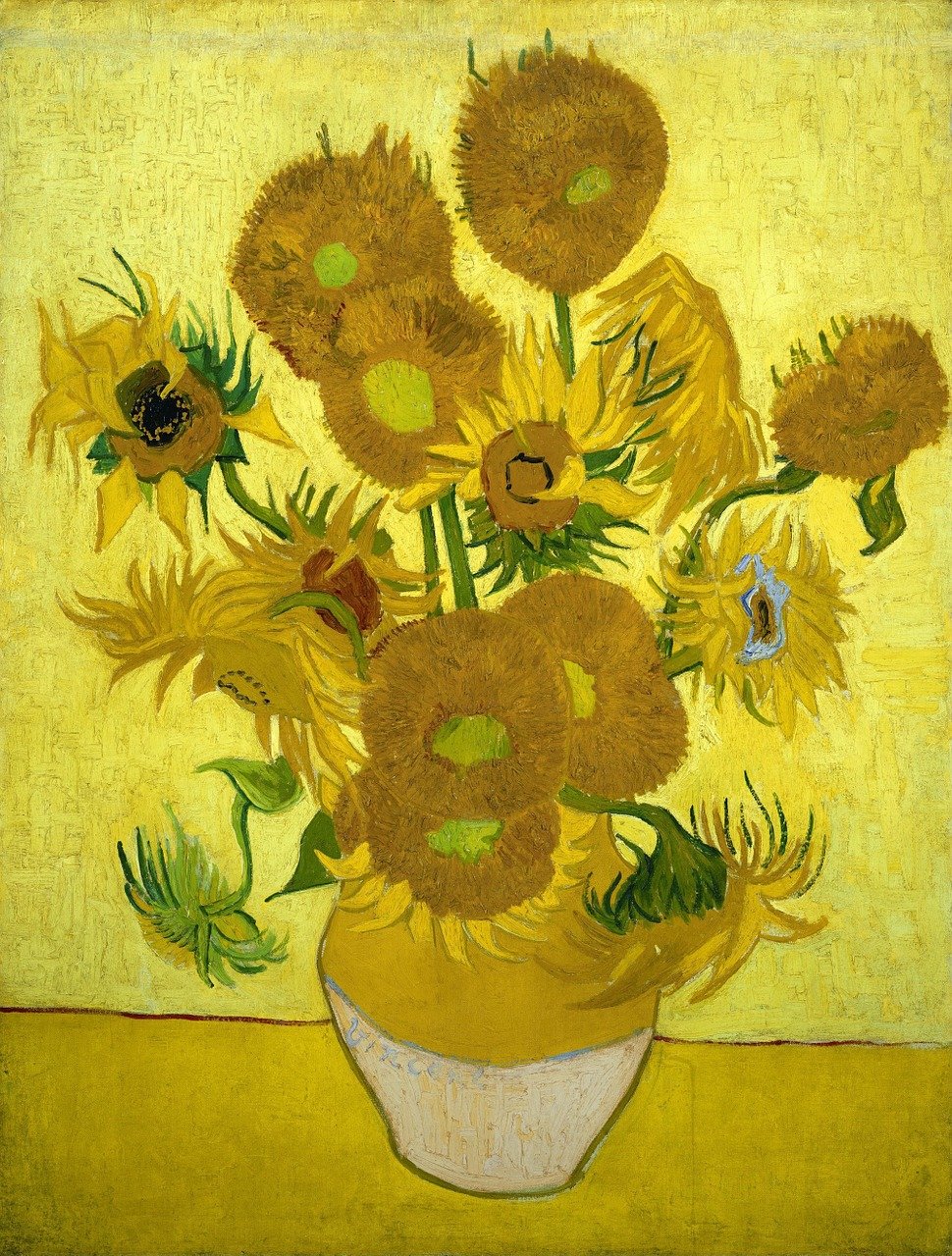
A painting from the Sunflowers series
Vincent and Gauguin
Vincent left Paris to escape from the fast-paced life there. But after arriving in Arles and painting at a rapid pace, he longed for the company of other artists. After all, the melancholy and his obsession with creativity was destroying his mental health. So, he invited artists from Paris. In July 1888, Paul Gauguin accepted his invite and came to Arles. They both had intended to start an art community in Arles. Initially, they got along well, exchanging paintings and debating about art. Vincent admired him and wanted Gauguin to treat him as an equal. But Gauguin was domineering and arrogant. This led to arguments between Vincent and Gauguin.
A horrifying incident
In December 1888, upon returning home after one such heated argument, Vincent suffered auditory hallucination and mental collapse, cutting off his left ear. He then gifted the severed ear to a prostitute in the hopes of acquiring her love. He then returned home. A policeman found him unconscious in his home the next morning and took him to a hospital. When he woke up the next day, Vincent couldn't remember what he had done the previous night.
Even though Vincent healed physically, the delusions and hallucinations continued. Moreover, 30 people signed a petition to get his house closed down. So, he voluntarily admitted himself to an asylum three months later, in May 1889.
Producing the best paintings
At the asylum, Vincent Van Gogh was given a room to stay and a studio to paint. He was even allowed to go outdoors to paint. During his 1-year stay at the asylum, he painted some of his most famous paintings, including 'Irises' and 'Starry Night.'
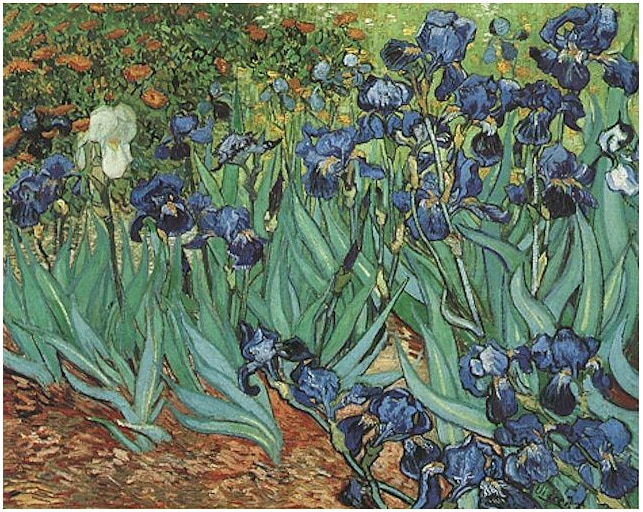
Irises, May 1889 - Van Gogh, Vincent. Irises, 1889. Getty Center.
The Van Gogh Gallery. “Irises.” 9 October 2020
https://www.vangoghgallery.com/catalog/Painting/244/Irises.html.
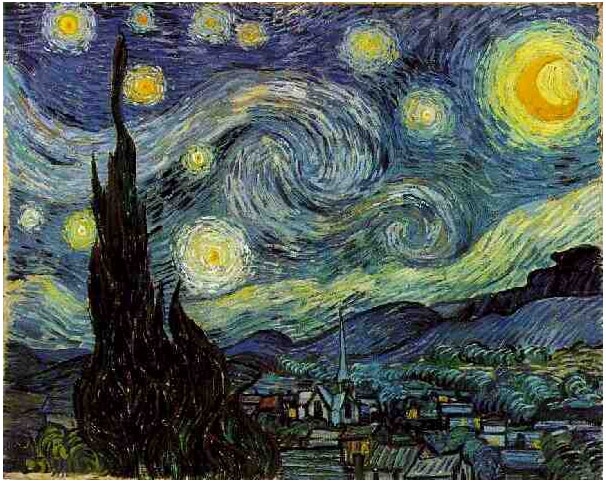
Starry Night, May 1889 - Van Gogh, Vincent. Starry Night, 1889. The Museum of Modern Art.
The Van Gogh Gallery. “Starry Night.” 9 October 2020
https://www.vangoghgallery.com/catalog/Painting/508/Starry Night.html.
Slowly, Vincent's works were becoming popular, and people were starting to acknowledge his skill. In January 1890, the French literary magazine 'Mercure de France' praised his work and called him a genius. When his paintings were displayed in Brussels, one of his paintings was sold for 400 Francs. Later, when his paintings were exhibited in the 'Artistes Independants' in Paris, Monet said that Vincent's paintings were the best in the show.
Meanwhile, Vincent's health was deteriorating. Hallucinations and breakdowns started to reoccur. Sometimes, it took one month for Vincent to fully recover and resume painting. But with time, Vincent accepted that his condition was incurable, and he had to live with it. So, in May 1890, he left the asylum and went to Auvers, a town north of Paris. But Theo was worried about his brother's condition. So, he made arrangements for a doctor to supervise him.
Final days
During the time he lived in Auvers, Vincent worked frantically, producing seventy paintings in seventy days, including portraits and landscape paintings of wheat fields. Vincent believed that his paintings would be admired by people who will be born 100 years later.
Death
Vincent's frantic pace of painting was slowly getting the better of him, and he started getting into depression and showing erratic behavior.
On June 27th, 1890, while taking a walk in the wheat field where he had been painting, Vincent Van Gogh shot himself in the chest. He then walked back to his room, where doctors attended him. But they couldn't save him. So, they left him alone. The next morning, when Theo came to be at his brother's side, Vincent was smoking a pipe. Vincent told him, 'The sadness will last forever.' Finally, 30 hours after he shot himself, Vincent Van Gogh died. His final words to his brother were, 'I wish I could die like this.'
Becoming famous
Theo himself was suffering from psychiatric problems and a sexually transmitted disease. His brother's death further weakened him. So, six months after Vincent's death, Theo died in an Asylum in the Netherlands.
Theo's wife, Johanna, who was a supporter of Vincent, gathered Vincent's paintings. In 1901, she displayed these paintings at a show in Paris. Soon, Vincent's fame grew tremendously, and people came to respect him. In 1914, she published the letters that Vincent Van Gogh sent and received. This increased the interest in the artist's life, whose paintings were already extremely famous by now.
Facts you probably didn't know:
- In 1987, Sunflowers became the most expensive painting that was sold at an auction. The record was broken two years later by another painting of Vincent Van Gogh called Irises. Today, Irises is the 15th most expensive painting ever sold.
- Vincent Van Gogh created about 2100 pieces of art in a decade after starting his professional art career.
- He sold only one painting in his entire life.
- Vincent Van Gogh died when he was 37 years old.
- He painted a portrait of Felix Rey, the doctor who treated him when he cut his ear, and gifted the portrait to him. But Dr. Rey gave it away because he didn't like the painting. The painting was worth $50 million dollars in 2016.
- Vincent's brother Theo was initially buried in Utrecht. But, in 1914, his wife reburied him in the grave next to Vincent's grave.
- Vincent Van Gogh's uncle's name was Vincent Van Gogh, and one of his nephew's name was also Vincent Van Gogh.
Conclusion
The Biography of Vincent Van Gogh
We hope that this biography of Vincent Van Gogh helped you learn about Vincent Van Gogh and how he struggled in his life. If you have a vision, but you don't want to work on it because it seems impossible, read the biography of Vincent Van Gogh. Despite all his struggles in life, he kept improving his skills and focused on his vision rather than making money. So, don't give up on your dream because it hasn't made you rich. Instead, improve your skills and keep working on it so that you can give your best shot when the opportunity comes knocking.
If you liked this biography of Vincent Van Gogh, you might like the following biographies as well:

